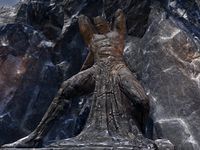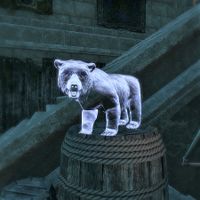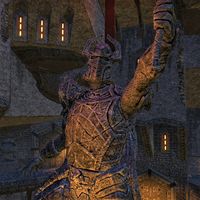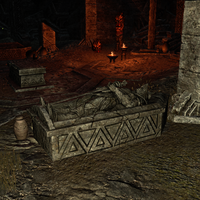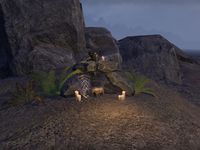According to Malacath-worshipping Orcs, Boethiah took exception to the lies being spread by the elven gods about Lorkhan, most especially those espoused by Trinimac. He defeated Trinimac and took on his form to spread "the truth of Lorkhan's test", the Tri-Angled Truth, and persuaded the followers of Boethiah and Trinimac to abandon Altmeri society.[1][2] Then, Malacath was created when Boethiah ate Trinimac, although Malacath himself says that this tale is far too "literal minded".[3][4][5][6] Trinimac's devout elven followers became the Orsimer.[3] Malacath is not recognized as a Daedric Lord by his peers,[3] which fits his sphere perfectly.
Some Orcs disagree with both stories and claim that Trinimac still exists and Malacath is a separate Daedric entity. At least two kings of Orsinium have tried to convert the Orcs back to the Aedric faith of Trinimac.[7][8] Trinimac is particularly well-known for spreading what is today one of the main understanding of the events surrounding Lorkhan. He preached that Lorkhan's idea for the mortal realm had been a trick all along and fomented war against Lorkhan and his followers. He believed that "tears were the best response to the Sundering", and encouraged hatred of Lorkhan.[1]
For the Orcs that revere Malacath, the afterlife promises rewards of immortality, abundant food and drink, and constant battle deep within the Ashen Forge. The Ashen Forge represents the culmination of the three constant truths of life among the Orc clans: the stronghold, the grudge, and the Code of Malacath. The Ashen Forge sits at the center of Malacath's own stronghold in the Ashpit, Malacath's plane of Oblivion, which consists of nothing but dust and smoke and ash. But his followers believe that the eternal emptiness contains all the things they hold dear and deem necessary to enhance their immortal existence. As the ultimate expression of the Orc stronghold, Malacath's Ashpit bastion stretches endlessly across the planes, extending even behind the stars to Aetherius, granting access to every worthy Orc who crosses from this life into the next. In Malacath's stronghold, every Orc is a chief, every chief has a thousand wives, and every wife has a thousand slaves to cater to their every need. The stronghold's walls rise one hundred feet into the smoky sky, constructed of polished steel and worked iron. Inside the walls, stone keeps, iron towers, and massive longhouses surround the central square that houses the Ashen Forge.[9]
The Ashen Forge fills the endless space within Malacath's smithy, a massive hearth that burns with a fire said to be hotter than the sun. The thing that keeps this fire alive is the adherence by the Orcs of Tamriel to the Code of Malacath, that is the heat comes from the burning, white-hot coals that are, the literal manifestation of the bloody code, which fuels the fires of emptiness, betrayal, and broken promises, imbuing every newly forged Orc with a foundation of grievances and resentments that will take them far in the mortal world. The hope is that every generation will be better than the next thanks to the efforts of the generation before it and its ability to adhere to and follow the Code of Malacath. Within this fire, every Orc must undergo the ritual of tempering when first they cross from this life to the next. They are thrust into the coals so that every grudge that they carry into the afterlife can be heated, melted, and eventually forged into the next generation of mortal Orcs. Some particularly memorable grudges can also be hammered and worked into weapons or armor of legendary stature upon the Ashen Anvil, the gigantic workbench that stands beside the Ashen Forge.[9]
Still, Malacath's faithful believe that they will be rewarded with immortality, nourishment, and constant battle deep within the Ashen Forge. A life-everlasting filled with endless days of warfare, endless nights of fine food and drink, and ongoing opportunities to prove their toughness and demonstrate the quality of their steel.[9] Orcish spirit-legions serve and fight for Malacath in the Ashpit. Dremora of the Doomdriven Clan are known to serve as marshals and commanders for the Orcish legionnaires.[10]
In contrast, Trinimac's followers believe that when they die, they ascend to Aetherius to join with their ancestors. Afterlife for Trinimac's faithful also consists of endless war and celebrations, but with a greater emphasis on once again spending time with family members who came before them.[9]
Orcs possess a unique spiritual element, that allows memories, and hopes to come together to form a spiritual totem, that is not only a clan totem but the very embodiment of a clan. Through the concept of fellowship, unity, and familial bonding, an Orc clan can form this unique spiritual connection. The Kalmur clan is the only known clan to have practiced this concept, and their familial love for one another and their kinship allowed for the manifestation of Atrozu, their clan totem.[11]
Orcish Funerary CustomsEdit
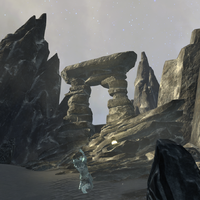
Both Malacath and Trinimac followers share cremation as their main funerary practice.[12][13]
When an Orc dies, his remains will be burned down to ashes, which can be handled by their kin. Ashes from chiefs and kings usually are forged into swords and shields, or any other item which their relatives or successors may want to remember the departed ones.[13] Commonly, more than one deceased was cremated at a time.[14]
It is custom to place the ashes of the Orcish dead under a cairn, out in the field, under the open sky. Over this cairn are placed their arms and armor. There, their relatives will come to honor their ancestors. Burial is not a practice among the Orsimer, although they respect other races' traditions.[15][16]
Sorrow mountain is the tallest peak in the Wrothgarian Mountains. The ancient Orcs of the early First Era used its heights as a burial ground for their chiefs and champions; the mightier the chief, the higher the Orcs placed his cairn.[17] Torug gro-Igron, one of their greatest heroes, had his cairn at the very summit of Sorrow.[18]
A unique and uncommon example of burial among Orcs and proof of their respect of other races killed in battle is the catacombs of Honor's Rest, in southern Wrothgar. This extensive mausoleum was built by Orc, Breton and Redguard masons after the destruction of the First Orsinium to place the corpses of both Breton and Redguards and the ashes of the Orcs who died in the long siege and, specially to place the rests of the heroes and rivals Baloth Bloodtusk and Gaiden Shinji, whose spoiled duel by King Joile of Daggerfall ended the war. These ruins were hidden and undiscovered until the reign of King Kurog in the Second Era.[19][20][21]
Orcish corpses are among the most sought after for the durability of their skin and the strength of their bones by necromancers. During the reign of King Gortwog, a delegation from the Worm Cult was sent to Orsinium for disposing of the Orcish dead. However, these negotiations never came into any agreement.[22] Probably, because Orsimer despise any form of necromancy or disturbance of corpses, souls, or remains of the dead.[23][16]
ReferencesEdit
- ^ a b The Changed Ones
- ^ The Anticipations — Anonymous
- ^ a b c The True Nature of Orcs
- ^ The House of Troubles
- ^ Varieties of Faith... — Brother Mikhael Karkuxor of the Imperial College
- ^ Lord of Souls — Greg Keyes
- ^ Pocket Guide to the Empire, 3rd Edition: Orsinium — Imperial Geographical Society, 3E 432
- ^ Malacath and Trinimac — Ugdorga, the King's Scribe
- ^ a b c d On Orcs and the Afterlife — Erisa Moorcroft, Scholar, Comparative Religious Studies
- ^ On Dremora Clans — Divayth Fyr
- ^ Khazasha's dialogue in ESO
- ^ Priest Uugus' dialogue in ESO
- ^ a b Chief Bazrag's dialogue in ESO
- ^ Long Live the King's quest in ESO
- ^ Brulak's dialogue in ESO
- ^ a b Rozag gro-Khazun's dialogue in ESO
- ^ Sorrow's description in ESO
- ^ Sorrow's Kiss's quest in ESO
- ^ The Ashes of Our Fathers's quest in ESO
- ^ Lozruth's dialogue in ESO
- ^ Corpse Preparation
- ^ Carzog's Demise quest in ESO
